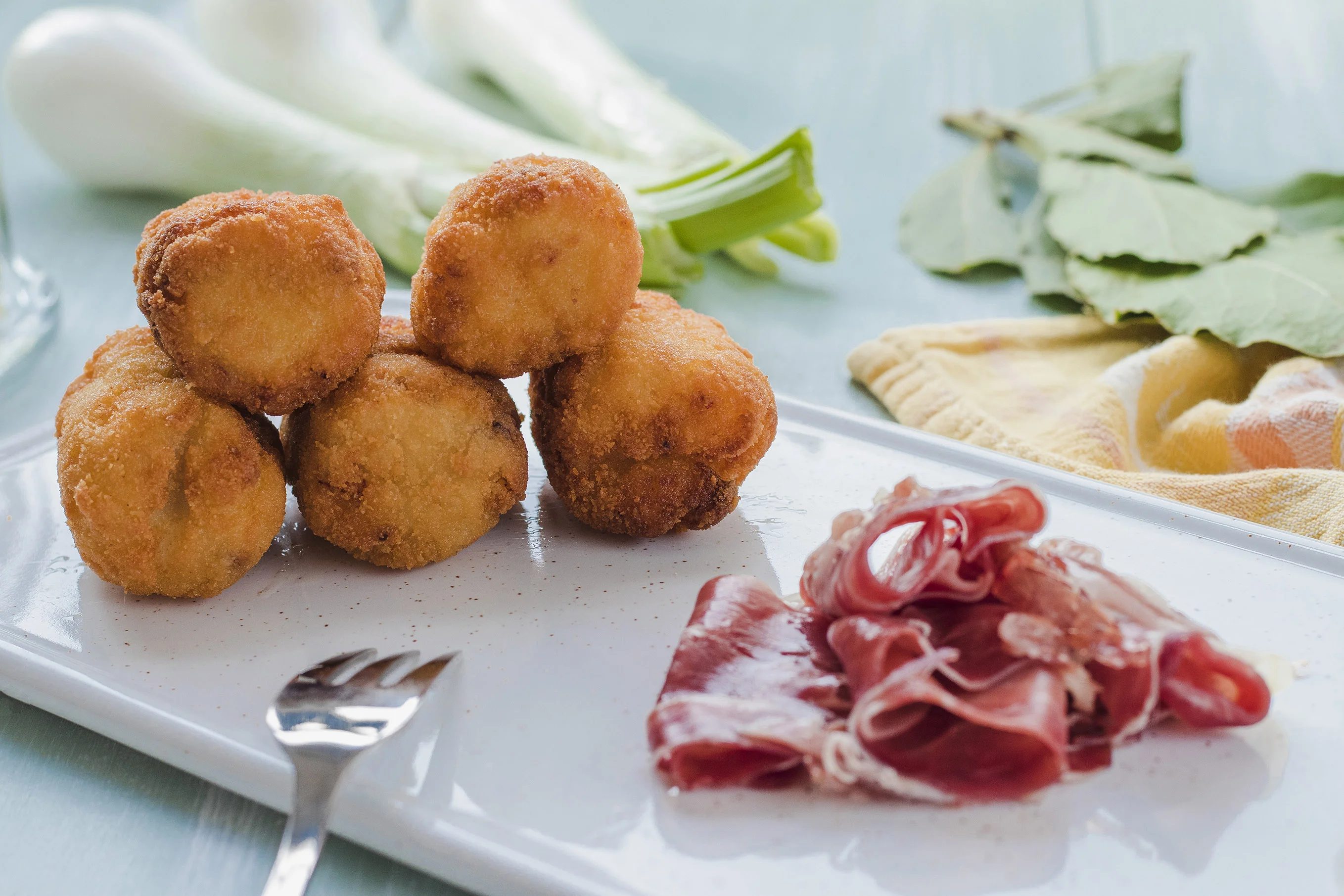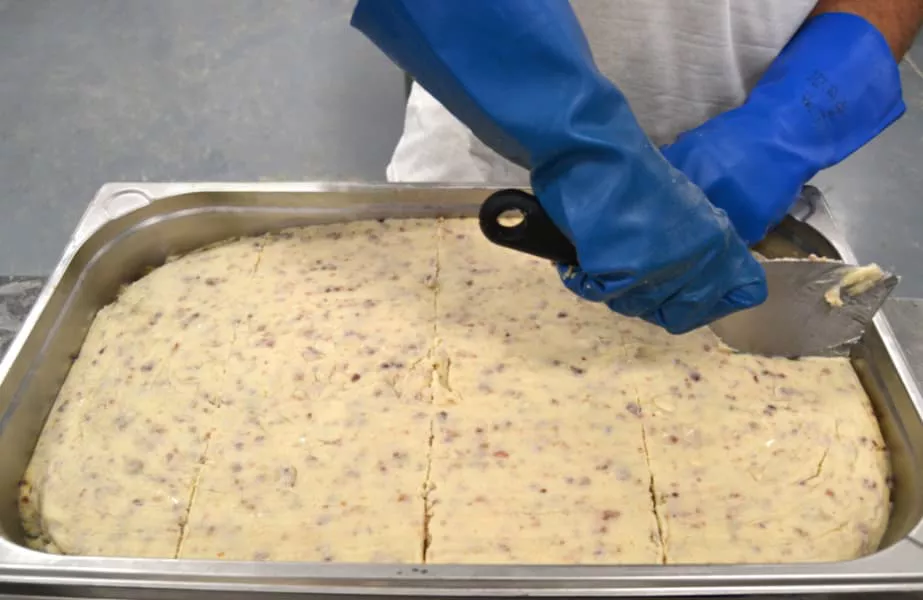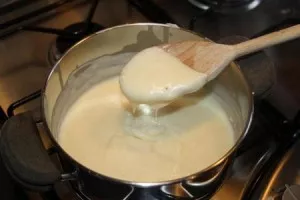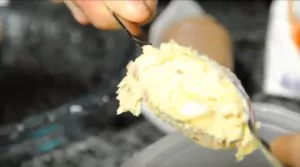What is a croquette?
Today we are going to talk to you extensively, almost like a guide about croquettes and a lot of interesting aspects that, as you know, you can find in our blog. Let's get to the point:
1.- Meaning of spanish croquettes
What is a croquette? It is a breadcrumbed and fried roll of food (sometimes about leftovers) used as 'tapas' and appetizers in many bars and restaurants. Croquettes are a portion of dough that can have different shapes, although traditionally it is usually oval or round. Their content usually consists of ingredients related to meat, fish, vegetables and even fruit or sweets.

2.- The origin of croquettes and much more.
As many of you will already know, although we often think that the croquette is a product that comes from Spain, in reality its origin is French. We could tell a brief history of croquettes, but today we are going to expand a little more. Croquettes are very popular in Spain, the Netherlands and Sicily.
The croquette did not arrive in mainland Spain until the end of the 19th century. This appetizer originated in France, where an aristocrat named Louis de Bechamel, who was in charge of the kitchen of King Louis XIV, was the "father" of croquettes. The "father" of croquettes worked as a tax collector and was superintendent of the household of the Duke of Orleans. It is said that he, or one of his assistants, created the besamel. This sauce was actually the result of the improvement of an older cream-based sauce by François Pierre de la Varenne, cook to the Marquis of Uxelles, to whom he dedicated it, as cooks often did for the nobility of the time.
But it was not until 1817 that the chef Antoine Camere served him croquettes a la royale at a dinner for the Archduke of Russia. It seems that this chef had the brilliant idea of covering the bechamel with a crispy coating.
However, it seems that there are more people who took credit for creating the basis of good homemade croquettes. There is an Italian theory that the croquette was created by Catherine de Medici's Florentine cooks who accompanied her to her wedding in Marseille to Henry II of Orleans in 1533. They claim to be the inventors of bechamel sauce thanks to the fact that this queen started a gastronomic revolution in France.
Finally, we can cite another hypothesis, albeit with little foundation. Duke Philippe de Mornay, Governor of Saumur and Lord of Plessis, has been credited with the invention of various sauces: Mornay, Lyonnaise, Port and Chasseur. By way of an anecdote, it is interesting to note, even if the credibility is not very high.
The original French croquette (croquette) was much harder than the one we know today. It is often said that "every master has his own recipe", as each country has adapted the recipe to its own customs, and it is common to find croquettes in Europe, but they are usually made of mashed potato in batter, without bechamel sauce or anything else.
The term croquette is attributed to the onomatopoeia croc or croquer (to crunch). And from there, croquette. In other countries it changes its name: kroket (Holland), krokett (Hungary), korokke (Japan), croquete (Portugal/Brazil), kroketten (Germany), croquette (in English). In Spain, some people colloquially mispronounce this product and call it <<cocreta>>, a term that is not currently accepted by the RAE.
In our country, people tend to use leftovers from other foods to add them to one of the most delicious starters that are a hit in online croquette shops. We are sure that in the future, there will be more and more recipes for homemade croquettes.
Did you know that International Croquette Day is celebrated every year on 16th January? Something that everyone loves should have its own special date and this delicacy is not going to be left behind.
3.- Properties of spanish croquettes
Did you know that gourmet croquettes have a high sodium content? This property helps you to control high blood pressure. Nor should we forget that, as they are made with milk, they provide a large amount of calcium, which is perfect for our bones!
In order to obtain the richest and healthiest croquettes, you will have to select the foods that have the vitamins you want. You can make meat croquettes, fish croquettes, vegetable croquettes or sweet croquettes, and remember to always place an absorbent paper towel on the croquettes so they don't get too much oil.
Many people always consider croquettes to be an unhealthy product to keep on a diet, and it is clear that being a fried snack in oil, its calories increase, but it cannot be considered a reason to give up the nutritional properties of croquettes.
4.- Calories of spanish croquettes
A croquette with an approximate weight of 25 grams normally has about 60 kilocalories and when fried, they can reach about 100 kcal. What is the trick to reduce the final calories?
The croquettes should be placed in the frying pan or deep fryer when the oil is very hot, thus creating a kind of layer of breadcrumbs around the croquette.
This prevents the croquette from absorbing the oil, and then we have to use the kitchen roll to remove the excess fat from the "gold liquid".
5.- Types of croquettes in Spain
How many times have you had leftovers from other meals and didn't know what to do with them? Well, if you didn't know, these "leftovers" can be reused to make tasty croquette recipes.
Here we show you all the different types of croquettes you can create:
- Croquettes of Iberian ham, pork shoulder, wild boar, oxtail, meat or any pork derivative (chorizo, bacon, black pudding, sausage, jerky, etc).
- Fish croquettes (cod croquettes, seafood croquettes, hake, monkfish, squid, prawn croquettes, etc.).
- Blue cheese croquettes (roquefort, idiazabal, parmesan, cabrales, etc).
- Boletus croquettes (mushrooms, mushrooms, etc).
- Chicken croquettes.
- Vegetable croquettes (courgette, cauliflower, artichokes, broccoli, spinach, chard, Confit leek, date and carrot croquettes, etc.).
- Sweet croquettes (chocolate, rice pudding, apple, etc.).
- Rice croquettes (typical in Japan and Italy).
- Potato croquettes (very common in Sicily).
- Cocido croquettes (leftovers of meat, chorizo, blood sausage and chickpeas).
6.- How are handmade croquettes made?
To make good, tasty croquettes, you first have to make a good bechamel sauce for croquettes.
For us, this is what really makes the difference between one good croquette and another.
Patience is a very important virtue when making this white sauce, because if we are not patient when making our croquette dough, it will be caked.
The essential ingredients to make this croquette dough are: flour, salt, onion, whole milk and butter.
If you use skimmed or semi-skimmed milk, you will be making a major mistake when making the main base of our delicious appetizer.
It is not necessary to add finely chopped onion to make the besamel, but it gives it an excellent touch of flavour.
6.1.- What steps should we take to make handmade croquettes?
1.- Chop the onion very finely and place it in a frying pan and poach it with a little oil. Add the main ingredient for the croquettes and when it is done, remove from the heat and leave to stand.
2.- To make the dough, pour the butter into a casserole over a medium heat until it melts. At this point, add the flour to the pan and stir until you get a yellow-coloured cream. Let the mixture cook, stirring constantly. Then add the milk little by little (it must not be cold, it must be at room temperature) together with the salt and continue stirring until you get the texture of the bechamel sauce that you want to give our croquette base. The dough must have consistency.
3.- Add the onion and any other ingredients you want to add to the sauce (ham, boletus, cod, etc.) and once it is ready, leave to cool for about 5 hours.
Shape the croquettes (we are now going to explain how to do this).
5.- In a bowl, beat 2 eggs well, without leaving any lumps. In a separate dish, put some breadcrumbs and what we have to do is pass the croquette through the breadcrumbs and then put it in the bowl with the egg.
6.- In a frying pan with very hot oil at 180ºC, fry the croquettes. It is important not to put too many croquettes in the frying pan or deep fryer at the same time, as they may break. They must have their own space so that they are perfect.
7.- Drain the croquettes on absorbent paper and put them on a plate to serve. Bon apetit! How to shape the dough for homemade croquettes
This is a matter of personal taste when it comes to shaping the croquettes. You can make them round, cylindrical or oval-shaped. You can do it in different ways depending on the croquette making utensils:
- With 2 spoons: this is perhaps one of the most common ways of making them without getting your hands dirty. To do this, take two soup spoons, put the bechamel mixture in one and shape it with the other.
- With your hands: if you want to get really greasy, use your hands and pour some water, oil or flour on them to make them easier to mould. To avoid getting stains, you could use plastic gloves and pour water or oil on them. With the palms of your hands, you will mould the croquette.

- Mould: one of the most convenient and modern ways to have all the croquettes homogeneous. They can then be cut with a knife.

- Piping bag: depending on the thickness of the tip of the piping bag, you will obtain one shape or another.

7.- Mistakes making spanish croquettes
To prevent our croquettes from suffering any kind of mishap, it is really important not to make the following mistakes in order to make the perfect croquette:
- Croquettes with strange shapes: to avoid this, the bechamel must be cold. You can help yourself, as we have seen in the previous paragraph, with a mould so that your croquettes are uniform.
- The croquettes are raw inside: if you buy frozen croquettes, it is important to defrost them before frying them. To do this, take them out of the freezer 30 minutes before.
- Soft croquettes: this happens when the bechamel sauce is not well done. To correct this, check that the sauce can be removed from the sides of the frying pan. This will indicate the degree of cooking of the sauce.
- The croquettes are burning: remember that the temperature of the oil is the key, remember this number 170º and don't put too many in at once. They need their vital space in the fryer or frying pan.
- The croquettes open up: the cause of this is that the temperature of the oil is not constant. It has to be kept between 170º and 180º at the most.
8.- How are spanish croquettes eaten?
Depending on where you are, you can eat them in 2 ways:
- With hands: if you are at an event or other type of celebration where people are standing, you usually eat with your hand.
- With cutlery: in restaurants or bars, they are eaten with cutlery as we are seated at a table.
9.- The most consumed gourmet croquette flavours in Spain (2022)
- Iberian ham (65%).
- Mushrooms (boletus, mushrooms, etc).
- Fish (cod is the benchmark).
- Meat (chicken, stew, oxtail, chorizo, black pudding, etc).
- Cheese (blue cheese, cabrales, Gorgonzola, Idiazabal, etc).
- Seafood (prawns, prawns, prawns, king prawns, baby squid, etc.).
- Vegetables (carrot, leek, courgette, etc)




